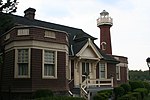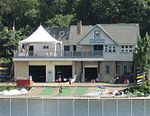The Ellen Phillips Samuel Memorial is a sculpture garden located in Fairmount Park in Philadelphia, Pennsylvania, United States. The garden, located along the left bank of the Schuylkill River between Boathouse Row and the Girard Avenue Bridge, was established by the Fairmount Park Art Association (now the Association for Public Art) and dedicated in 1961.
The idea for a series of sculptures came from Ellen Phillips Samuel, a philanthropist who left a significant amount of money to the art association in her will, with the stipulation that it be used to erect public sculptures that would represent the history of the United States. Following the death of Ellen in 1913 and her husband in 1929, the association organized a committee to oversee the creation of these monuments, with architect Paul Philippe Cret developing a plan for three connected terraces with distinct themes represented by the sculptures present in them. To select the sculptors for the memorial, the association organized three international art exhibitions held at the Philadelphia Museum of Art in 1933, 1940, and 1949, that attracted hundreds of sculptors and saw attendances in the hundreds of thousands. The final sculpture was erected in 1960 and the memorial was dedicated the following year.
The memorial has received generally mixed to negative reviews from art critics, with many criticizing the relationship between the sculptures and the surrounding architecture. For example, in a review of the memorial, architect Alfred Bendiner praised the architecture, but called the choice of sculptures "a most irritating collection of uninteresting examples of the work of outstanding men and women, most of whom have done much better elsewhere". Penny Balkin Bach, an executive director of the art association, has stated that the memorial is "as much a monument to the confusion about what constituted modern public art" as it is a memorial honoring Samuel.












